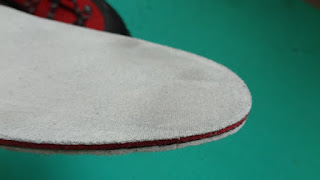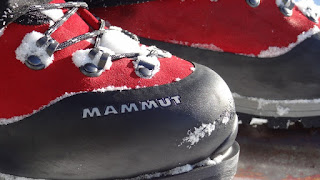If Santa were a mountaineer he'd wear the Mammut Meridian GTX boots. :-)
So even though I have't actually seen Santa, I got a parcel from Switzerland with these boots inside. They made quite a travel loop and I guess they were destined for me since they were manufactured in my country (it says that on a label inside: Made in Romania).
Download this vector design here
After a few years of rock climbing and mountaineering, I figured out I only need three types of shoes:
- climbing shoes
- light trekking shoes (for approach routes and hiking) - I don't wear any boots in the summer
- and a good pair of winter mountaineering shoes
Design and first impression
As with everything Mammut, you get a premium product with a premium emotion attached.
Of course I'm biased - I'm still amazed by the social media policy Mammut deploys.
Speaking of amazement, I also learned that a prolific climber and alpinist from my home city (Titus Gontea) was involved in their Peak Project. He got to keep all the Mammut wear they had on while climbing a classic alpine wall route in our Bucegi Mountains.
So yeah, they're generous and I'm privileged to be sponsored!
Some may argue that the red color is too conspicuous and I agree.
I felt a little self conscious when I wore them in the city (we had record snowfall and frost this past winter - January and February 2012) coz everybody was looking down at my boots. Then I got cocky - of course you're looking, aren't they cool?. :-)
But as a general rule, bright colors are good for mountain sports where you wanna be spotted fast in case you get injured. So a red boot sticking out of the snow means the rescue team is gonna see you and pull you out of that avalanche faster. Damn! That's a morbid example but you get the point.
Comfort and fit
My old pair of mountain boots caused me blisters for a while until they eventually became less rigid and modeled around my foot. But that was a pain in the...well, a pain just below Achilles tendon.
So I was cautious with these boots, taking them out in the city and in short treks at first. But the fit was just right. No blisters. Just a small fatigue in the feet due to treading to and fro on high street with stiff soles (I was being cocky, remember?).
In deep powder or in hard snow you walk through like a hero and kick and smash everything under your feet and fell like you have two military tanks in your feet. You're indestructible.
Depending on how free you want your ankle to be, you can lace all the way to the top or just the first metal hooks on the cuff. I usually lace all the way but keep it rather loose towards the upper part of the cuff.
My size is 42 European (8 UK - 9 USA) and the boots came in 42 which was perfect. I can wear them with a single sock or with two pairs (one thin and one thick).
A nice combination is a thin merino wool sock close to the skin and a thicker Primaloft over it - I'm not that technical and brand aware with this stuff but I got some cool socks from Röjk and I enjoyed pairing them with the Meridian GTX Boots.
Functionality
This is a mountaineering boot, designed for climbing on rock and ice in relatively high altitudes. The highest mountain in my country is 2544 m (8346 feet) but the Alps are not far away and a long lasting boot like the Meridian will be with me a few years from now.
They're not very light but I think their weight is reasonable (2.3 kg/pair - 5.07 lbs) - the inertia helps you kick with less effort in hard snow or ice.
Features
- Vibram sole
- Front and back margin for fast clip in crampons (love that)
- Gore Tex membrane underneath the leather
- Fine grain leather with waterproofing treatment
- Neoprene cuff for snug fit on the calf - and for keeping the snow out
- Adjustable tongue
- Rubber rand around the boot
- Loop for hanging the boots
- Technical foot bed (insole)
You can mount any type of crampons on these boots. However, I prefer the technical M10 by Petzl (review here) for fast mounting and fine precision in mixed climbing (rock, ice and snow). Didn't get any chance to actually climb with crampons this winter though.
Thermal insulation - I guess this depends on the person who's wearing the boots.
My feet have been slightly frostbitten a few years ago - coz I left my boots outside during the night and got them on freezing the next day in this winter tour (when Highball Blog was a stream of personal outdoor adventures) - and I've remained somewhat sensitive to cold. Just as a friend of mine who climbed in the Himalayas predicted.
In regular winter temperatures - let's say -10° C (14° F) - wearing dry socks, you'll be warm coz the boot is insulated.
However, after hiking trough the snow for a few hours and then being stationary in -17° C (1.4° F), my feet being damp from the perspiration, I could feel the frost nipping my toes. Anyway - that was the only bad experience regarding warmth (or its lack thereof) but, again, I'm subjected to being cold at my feet just as I'm subjected to windburn now...
More about my winter bivouac here: Sleeping in the snow.
The rubber rand protects the boots from unavoidable bumps against rocks which would normally leave scratches on the leather. It also contributes to the waterproofing of the boot - useful when you need to cross shallow streams.
You can adjust the tongue (velcro) for creating more or less space in the toe box. When you wear just one pair of socks this feature can help you get a closer fit as well.
- Rugged yet fashionable
- Waterproof leather and Gore Tex membrane (for the time when the leather waterproofing treatment wears off, unless you maintain it with a waterproofing spray)
- Offers a firm stand and good kicks
- Narrow heels favors descending in hard snow where you have to kick with your heel to make steps
- Pricey (but so are iPhones and Apple computers and lots of people buy them)
- I wish the tongue was removable just like in my old LaSportiva Makalu (for better overnight ventilation and quick drying)
- Lack of lace lock between lower lacing guides and upper metal hooks (this allows you to distribute the pressure better along your foot and if for some reason the laces loosen, the first part of your foot will still be firmly held coz the lace is locked - La Sportiva has that)
Where to buy your Mammut Meridian Gore Tex boots
Most likely you can order these at your local mountain shop. But I guess you'd wanna try them on first so you can take a better decision.
If you wanna buy them online, you can find them on Amazon.co.uk or on other European online stores:
Conclusion
A solid mountaineering boot which you can use for all your winter escapes in the mountains. Works with snowshoes (Atlas 1225), crampons and will serve you well on and, especially, off trails and on icy alpine walls.
I'd buy them. Doesn't that say it all? :-)
Leave a comment and I'll reply. Cheers!
Thanks for stopping by! Share this article with your friends.




































Hi Constantin
ReplyDeleteThank you very much for this really long and nice review about the Mammut Meridian GTX mountaineering shoe! Nice to see that you like it and it fits you well! Have fun with your new shoes in the Romanian mountains.
Regards
Dominik
Thank you for the opportunity, Dominik. Love the boots! :-)
DeleteI find it strange that Mammut haven't fitted lace locks to this boot. When the GTX was built by Raichle it had lace locks. They must not think they are necessary anymore.
ReplyDeleteYeah... I love the lace locks in my La Sortiva boots. To me, those things are quite useful.
DeleteMammut is receptive to constructive criticism - hope they'll add the lace locks.
Those lace locks like in La Sportiva aren't so good so Mammut decided it is better to use the open hooks.In my opinion this is way better. Because of friction the lace locks they will loosen up over time.And Mammut lacing have a 3 zone which you can customize.Watch the video above
ReplyDeletehttp://www.youtube.com/watch?v=6lHbsE89ces
You can always make a double cross to the same hook so the laces will stay more secure.
I see your point but I have the LaSportiva as well and I enjoy those lace locks. Cheers!
Delete